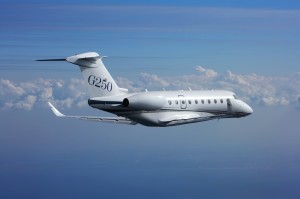 SAVANNAH, Ga., – The Gulfstream G250 flight-test aircraft have completed several ice-test certification points in anticipation of the aircraft’s certification later this year.
SAVANNAH, Ga., – The Gulfstream G250 flight-test aircraft have completed several ice-test certification points in anticipation of the aircraft’s certification later this year.
Serial Number 2001, the first aircraft to join the flight-test program on Dec. 11, 2009, has flown with simulated ice shapes applied to the non-heated areas of the aircraft, including the nose, tail, winglets and engine pylon. These tests were used to evaluate the aircraft’s handling, stability and control characteristics in icing conditions.
S/N 2002, which joined the flight-test program on March 24, 2010, has completed anti-ice system dry-air testing, clearing the way for certification flight testing into known icing conditions. The aircraft is poised to visit the United States in search of natural icing. The G250 uses an anti-ice system similar to Gulfstream’s large-cabin aircraft. Heated bleed air from the engines is routed to the leading edges to prevent ice formation.
The three aircraft in the flight-test campaign have completed more than 220 test flights, spending more than 700 hours in the air. The longest flight was more than seven hours. The maximum speed achieved was Mach 0.85, and the maximum altitude was 45,000 feet (13,800 m). On Dec. 9, 2010, all three flight-test aircraft flew simultaneously for the first time.
Since its first flight on Dec. 11, 2009, S/N 2001 has confirmed a wide range of data, including minimum control air speeds, initial cruise performance and flight-control system/ flight-control law performance.
Additionally, S/N 2002 has undergone certification for smoke evacuation, auxiliary power unit electrical loads, fuel system functionality, the cabin pressure control system, overall aircraft loads and stall characteristics with different centers of gravity.
S/N 2003, the last aircraft to join the flight-test program, has undergone avionics certification testing and numerous systems checks. Additionally, S/N 2003 made its first trans-Atlantic crossing in support of the National Business Aviation Association Conference and Exhibition in Atlanta last year. It also performed far-field noise and high-field elevation testing.
While the test aircraft continue to push through the flight-test campaign, several other activities are under way on the ground. Testing is ongoing in the Integration Test Facility at Gulfstream’s headquarters in Savannah, where engineers are evaluating the PlaneViewTM 250 avionics system by examining software and hardware integration, systems development and human factors. They’re also developing and validating the procedures that will be used in the Airplane Flight Manual. Optional avionics features, such as the head-up display and Gulfstream Enhanced Vision System II are also being tested in the ITF.
Additionally, all structural limit and ultimate load tests have been successfully completed. The fatigue test article has been moved to the structural test hangar, where it will be used to test the structural integrity of the airframe over more than 40,000 cycles.
At the same time, manufacturing of the first non-test aircraft, S/N 2004, continues at Israel Aerospace Industries near Tel Aviv. The forward, center and aft fuselage sections have been joined, and systems installation is under way. Production of the interior furnishings is under way at Gulfstream’s mid-cabin completions center in Dallas, where the G250 will be outfitted and painted.


